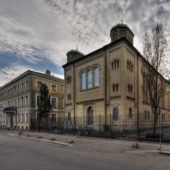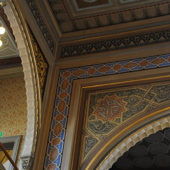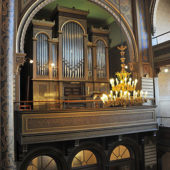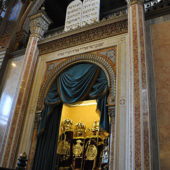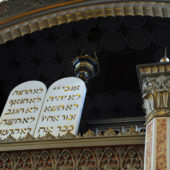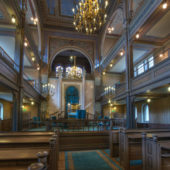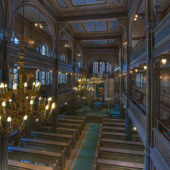After more than 14 years of planning and debate this synagogue was erected in a prominent location by a canal in central Goteborg.
Jews were not legally allowed to live in Sweden until the 1770s, prior to this time they lived and practiced their rituals in secret. It is recorded that Samson Efraim and his son visited Goteborg and Stockholm on business in 1702. Jewish businessmen increasingly came to Sweden in subsequent years, due to the demands of the East Indian Trading Company. In 1733 Jews were allowed to attend auctions in Goteborg and a small Jewish community of eight people lived in Stockholm until 1734.
Aron Isak, a German seal engraver, was the first Jew to receive permission to live as a Jew in Sweden. He was first offered citizenship if he would become a Christian, to which he replied, “I would not change my religion for all the gold in the world.” This impressed the Lord Mayor of Stockholm, who convinced King Gustav III to grant him citizenship as the first Swedish Jew. He was allowed to bring Jewish families with him so that there would be at least ten Jewish men to hold a minyan (religious/prayer service). In 1780 the first Jew settled in Goteborg and in 1782, legislation was passed permitting Jews to settle in the cities of Stockholm, Goteborg, Norrkoping, Karlskorna and Marstrand (the latter only from 1775-1794), without converting to Christianity. In 1776 the first Jewish cemetery in Sweden was established. In 1782 Jews were allowed to build synagogues, perform services and engage in businesses and crafts that were not subject to guilds.
By 1840 approximately 900 Jews lived in Sweden. In 1838 King Charles XIV began to remove some of the restrictions placed on Jews, allowing them increased civil rights and legal protection. By 1870, the Jewish emancipation increased yet tt was not until 1951 that Jews could hold a public office. The population of Jews in Sweden increased tremendously between 1850 and 1920, primarily due to Jewish immigration from Russia and Poland. In 1920 there were 6,500 Jews in Sweden. Immigration was regulated following WWI. Fear of a large scale Jewish immigration led to student demonstrations at Uppsala and Lund Universities in 1938. From 1933 to 1939 only 3,000 Jews were allowed to immigrate to Sweden and an additional 1,000 were allowed to travel through Sweden on to another country. However, once the Nazi regime’s intent became clear, Sweden opened her doors to immigration and was very involved in trying to save Jews, although it was a “neutral” country. In 1942 Sweden permitted 900 Norwegian Jews to immigrate into the country and in October of 1943 gave asylum to over 8,000 Danish Jews who escaped in small fishing boats, as well as the thousands of Hungarian Jews saved by Swedish diplomat Raoul Wallenberg. Count Folke Bernadotte helped bring both Jews and non-Jews out of concentration camps. Sweden also accepted refugees from the Baltic Republic, Lithuania and Estonia.
Post WWII, many Holocaust survivors were brought to Sweden for rehabilitation. In the 1950s there was a law passed prohibiting incitement of ethnic hatred. In 1956 Sweden accepted hundreds of Hungarian Jews fleeing the communist regime and in 1968, accepted thousands more from the communist-led witch-hunts. Jews from Czechoslovakia and Poland immigrated to Sweden, many of whom were intellectuals, university students and young professionals. Between 1945 and 1970 the Jewish population in Sweden doubled. Today, there are approximately 18,000 Jews in Sweden, with the largest community of over 5,000 people living in Stockholm. Swedish Jewry today is active in international welfare activities.
The Jewish community in Goteborg built its first synagogue in 1808. However, at a parish meeting on April 11, 1841, discussion was raised regarding the fact that the congregation of 415 members had outgrown the present synagogue. Michael Warburg proposed a building fund to finance the new property, building and schoolhouse. This was agreed upon; however, finding a suitable piece of land became very difficult. After two years of being unable to find a suitable property, and with the roof of the current synagogue on the verge of collapsing, the congregation was in dire straits. They finally found two plots of land next to each other on a canal, which would meet their needs and purchased them. Plans were drawn up by contractor August Krüger. Finally, on October 12, 1855, the Göteborg Synagogue was completed.
The Göteborg Synagogue shows a blend of Renaissance and Byzantine architectural styles. The massive stone Synagogue features large arched windows on the ground floor, double arched windows on the second floor and triple arched windows on the third floor. Four Byzantine styled turrets arise from each of the four corners of the edifice. Black wrought iron fencing surrounds the property. Inside, the prayer room is impressive with the sweeping archways, columns, detailed woodwork, and Byzantine artwork painted with tremendous intricacy all over the ceiling, columns, both stories of the women’s galleries, and walls. The bimah at the front of the prayer room is a raised platform with a turned wood balustrade. Against the wall is the elegant Aron Kodesh, flanked on either side by columns with Corinthian pillars. The crosshead and pediment have a Moorish flair and the entire Aron Kodesh is painted with detailed Byzantine artwork. Two tablets featuring the Ten Commandments inscribed in Hebrew sit on top of the Aron Kodesh. A large wood tivah (reader’s desk) sits on the platform in front of the Aron Kodesh. Large, elegant gold, lit menorahs sit on either side of the wood balustrade. The two-storied women’s galleries runs along both the sides and back of the prayer room, supported by columns running from the ceiling to the floor. Three stories of arched windows along the side walls fill the sanctuary with light and three magnificent arched, stained glass windows sit in the arch above the Aron Kodesh. Graceful, multi-armed brass chandeliers are situated throughout the prayer room. Simply carved wood benches fill the sanctuary.

